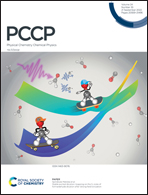A study of the interaction between TMAO and urea in water using NMR spectroscopy†
Abstract
Trimethylamine N-oxide (TMAO) and urea are small organic biological molecules. While TMAO is known as a protective osmolyte that promotes the native form of biomolecules, urea is a denaturant. An understanding of the impact of TMAO and urea on water structure may aid in uncovering the molecular mechanisms that underlie this activity. Here we investigate binary solutions of TMAO–water, urea–water and ternary solutions of TMAO–urea–water using NMR spectroscopy at 300 K. An enhancement of the total hydrogen bonding in water was found upon the addition of TMAO and this effect was neutralised by a mole ratio of 1-part TMAO to 4-parts urea. Urea was found to have little effect on the strength of water's hydrogen bonding network and the dynamics of water molecules. Evidence was found for a weak interaction between TMAO and urea. Taken together, these results suggest that TMAO's function as a protective osmolyte, and its counteraction of urea, may be driven by the strength of its hydrogen bond interactions with water, and by a secondary reinforcement of water's own hydrogen bond network. They also suggest that the TMAO–urea complex forms through the donation of a hydrogen bond by urea.



 Please wait while we load your content...
Please wait while we load your content...